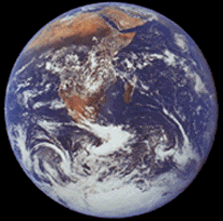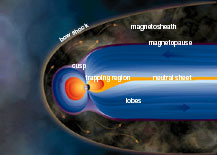Click on image for full size
Image courtesy of NASA/JPL
The Equator is Growing!
News story originally written on August 7, 2002
Earth may look perfectly spherical from space, like a giant marble, but it actually isn't! Since the first satellites were launched, scientists realized that Earth is not a sphere. Instead, our planet is wider around the equator because matter is forced out as Earth spins (just as you feel you are pushed right when your car turns fast to the left). However, Earth doesn't stay the same, and scientists have been tracking some interesting changes in our planet's shape.
Standing on Earth's surface can not see the small changes in Earth's shape but researchers have been watching the equator shrink slowly over the past few decades with satellites, a process that they believe has been going on since the last ice age 18,000 years ago. Since the ice age, glaciers at the poles have been melting slowly as global temperatures warm, allowing magma under Earth's crust to move towards the poles once the heavy weight of ice was no longer squashing them. This allowed the equator to shrink as the molten rock (magma) moved away.
For the past four years, however, Earth has been doing something quite different. Researchers at Raytheon and NASA's Goddard Space Flight Center have been watching the equator grow larger. Since we know that glaciers are still melting at the poles, scientists are puzzled why the process would change.
For Earth's equator to increase in size, material must have been moved from somewhere else on the planet. One hypothesis is that molten rock has been moving within the Earth to below the equator. This may have been caused by the brief reversal of the Earth's magnetic field that occurred in 1999, which happens about once every 10 years. One of these reversals may have caused changes in the circulation of magma in the Earth's interior.
Another hypothesis is that there is more ocean water piling up at the equator. As the polar ice caps melt, they add more water into the oceans, which will move with the ocean currents towards the equator.
Whatever the reason, the researchers believe that this change in the shape of Earth is the result of long-term natural variations, and is not anything that humans have done to the planet.















